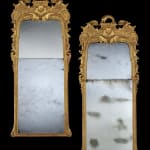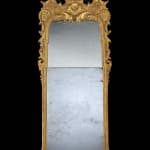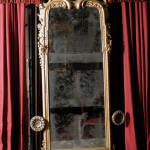THE GODOLPHIN PIER GLASSES ATTRIBUTED TO JOHN BELCHIER
W: 34” / 86.25cm
Further images
-
(View a larger image of thumbnail 1
)

-
(View a larger image of thumbnail 2
)

-
(View a larger image of thumbnail 3
)

-
(View a larger image of thumbnail 4
)

-
(View a larger image of thumbnail 5
)

-
(View a larger image of thumbnail 6
)

-
(View a larger image of thumbnail 7
)

-
(View a larger image of thumbnail 8
)

-
(View a larger image of thumbnail 9
)

Provenance
Possibly supplied to Francis Godolphin (1678-1766), 2nd Earl of Godolphin for Godolphin House, Cornwall or Stable Yard, St. James’ Palace, London and by descent
Property of a Nobleman, Christie’s London, 7 April 1983, lot 51 (GBP 60,000)
Acquired by Henry Francis Dupont, Winterthur Museum, Delaware, reputedly for his private collection
Christie’s, New York, 2 February 1991, lot 208 (USD 143,000)
Christie’s New York, 22 April 1999, Lot 143
Private Collection: East Coast, USA
Literature
Bowett, A., Early Georgian Furniture 1715-1740 (Woodbridge, 2009) p. 292, plates 6:50-1
Child, G., World Mirrors 1650-1900 (London, 1990), p. 78, fig. 51
Cornforth, J., Early Georgian Interiors (London, 2004), pp. 280-85
Edwards, R. and Jourdain, M., Georgian Cabinet-Makers, rev. ed. (London, 1946) p. 99, fig. 33
COMPARE
Pier glasses supplied by Belchier in 1723 and 1726 for John Meller, Erddig Hall, Wales (NT 1146961 & NT 1146960)
Mirror attributed to Belchier in the Metropolitan Museum of Art, New York (Accession No. 46.116)
Mirror illustrated Synge, L., Mallett’s Great English Furniture (London, 1991), p. 89, fig. 94
Publications
Beard, G. and Goodison, J., English Furniture 1500-1840 (Oxford, 1987), p. 67, fig. 4
The present mirrors compare closely with the two pier glasses supplied by John Belchier (1699-1753) to Erddig Hall in Wales on 15th July 1723 and 6th June 1726 for the two best bedchambers for £36 and £50.1 The earlier mirror is the same stepped rectangular form as the present mirrors. The 1726 mirror is nearly identical, with bold central scrolls and matching eagles’ heads. The cost of £50 for this single mirror provides an idea of the significant price the present pair will have commanded when they were supplied in the early eighteenth century.
The mirrors compare with Belchier’s attributed work, namely a mirror in the Untermyer Collection in The Metropolitan Museum of Art, New York and another formerly with Gerald Hochschild, which both feature a stepped plate, scrolls and eagles’ heads.2 Belchier was an important cabinet-maker of the early eighteenth century, described in the London Evening Post on his death as ‘for many years past a very eminent cabinetmaker’.2 Erddig Hall is his most significant known commission. In addition to the mirrors, he likely supplied the State Bed in 1720 which features eagles’ heads on the tester, prefiguring those on the 1726 pier glass and on the present mirrors.
The dolphin naiant in the pediments is almost certainly an heraldic device, indicating that the mirrors were made for a patron. Such a dolphin is borne by a number of families including the Kennedys of Culzean and Cassilis and the Courtenays of Powderham, Devon, but on account of their prominence at court in the early eighteenth century perhaps the most likely candidates are the Godolphins of Rialton and Helston, of whom a dolphin has been the symbol since at least the sixteenth century, as a reference to their name and landholding in Cornwall.
A dolphin naiant as it appears in the mirrors’ crests is first seen in the arms of the Sidney Godolphin, 1st Earl of Godolphin (1645-1712) - who under Queen Anne assumed such prominence alongside his chief ally John Churchill, the future victor of Blenheim and 1st Duke of Marlborough, that the two were named ‘the Duumvirs’ - and the mirror carvings relate closely to the pair of carved, parcel gilt and painted wooden dolphins naiant (NT 169408) thought to have originally served as helmet crests for Sir William Godolphin (c.1518-70).
That patron in question may have been the 1st Earl’s son, Francis Godolphin (1678-1766), 2nd Earl of Godolphin, an MP and Peer, privy councillor, Lord of the Bedchamber, Groom of the Stole and Governor of the Scilly Islands. Eminent in social circles, Francis will have been familiar with the most accomplished and fashionable London cabinet-makers of the day. Further, his uncle, Dr Henry Godolphin, was Dean of St. Paul’s where Belchier supplied window glass and his workshop was located, and it is possible that it was through this connection that Godolphin commissioned the present mirrors.
Francis married a daughter of Churchill, Lady Henrietta, who was notorious for her attachment to dramatist William Congreve, the suspected father of her fifth child, Lady Mary, whom Francis nonetheless accepted as his own. Francis was one of the founding governors of the Foundling Hospital, an orphanage charity created to tackle the problem of child abandonment. He also had the distinction of owning one of the founding thoroughbred sires, the Godolphin Arabian.
It is said that he read only two works, Burnet’s History of my own Time and Cibber’s Apology. When he had perused them throughout, he began them again.4 Francis died at his house in St James’ on 17th January 1766 and was buried in Kensington Church, just down the road from the Rolleston Gallery.
1 NT 1146960-1; Bowett, A., Early Georgian Furniture 1715-1740 (Woodbridge, 2009) p. 292, pls. 6:50-1
2 Accession No. 46.116; Synge, Mallett’s Great English Furniture, 1991, p. 89, fig. 94
3 G. Beard, C. Gilbert, Dictionary of English Furniture Makers 1660 - 1840 (Leeds, 1986), p. 59
4 George Clement Boase, ‘Godolphin, Francis’, Dictionary of National Biography, 1885-1900, eds. Leslie Stephen, Sidney Lee (London, 1890)








